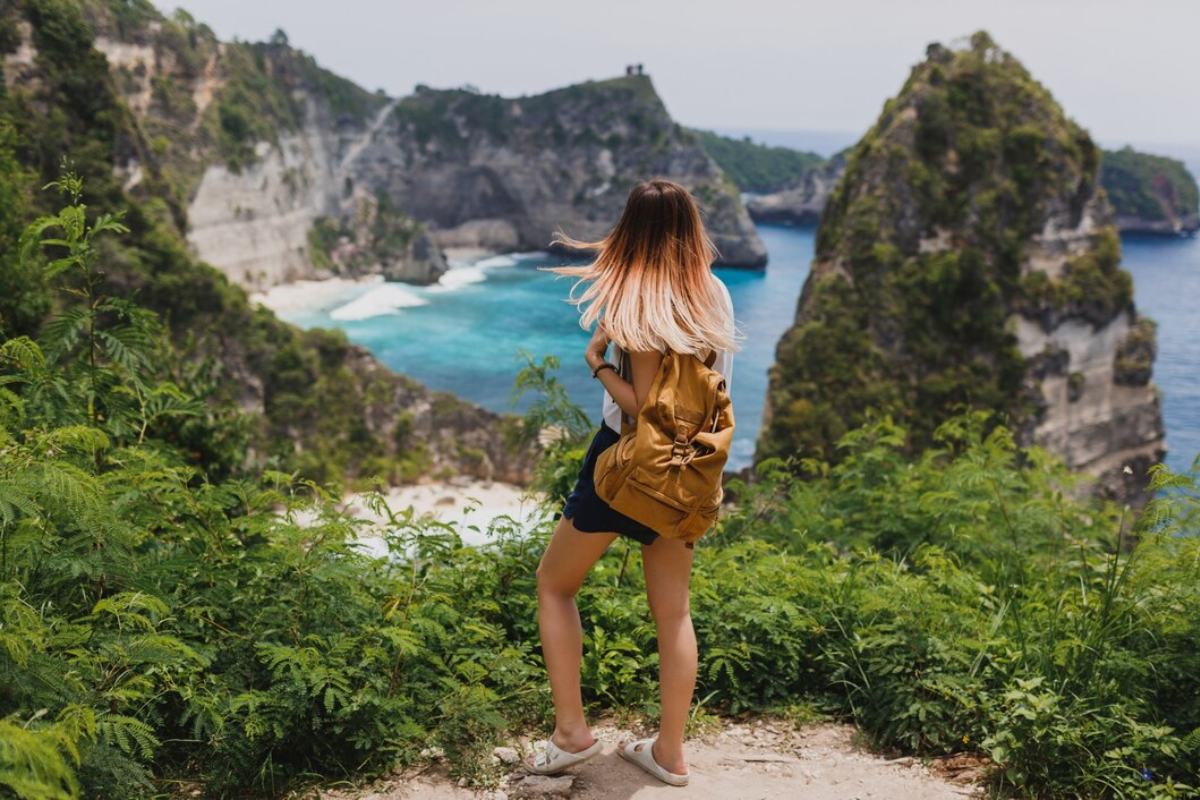Planning a trip to Bali? Whether it’s your first time or a return visit, this Bali travel guide will help you get the most out of your journey. Known for its stunning landscapes, friendly locals, and spiritual energy, Bali is one of Southeast Asia’s most loved travel destinations. This article will walk you through everything from the best time to visit and where to stay, to how to get around and what to eat — all in one place. Let’s make your Bali trip smooth, fun, and unforgettable.
Why Bali Continues to Capture Travelers’ Hearts?
Bali isn’t just a beach destination — it’s a feeling. The moment you arrive, you’ll notice the island’s peaceful rhythm, artistic energy, and deep spiritual roots. From the scent of incense floating through the air to the sound of distant temple bells, Bali has an atmosphere that soothes the soul.
The island’s natural beauty is just as impressive as its culture. Think lush rice terraces in Ubud, coral-filled waters around Nusa Penida, and sunset views along the cliffs of Uluwatu. The Balinese people are warm, welcoming, and deeply connected to their traditions. Daily offerings, temple ceremonies, and community festivals bring color and meaning to everyday life.
Whether you’re a solo traveler seeking peace, a couple looking for romance, or a family wanting fun and ease — Bali adapts to every mood.
Best Time to Visit Bali for Weather, Prices, and Experiences
Bali’s tropical climate makes it a year-round destination, but some months are better depending on what you want to do.
The dry season, from April to October, is the most popular time. The skies are clear, humidity is lower, and it’s perfect for beach days, hikes, and exploring temples. July and August are peak months, especially with international holidays, so expect more crowds and higher prices.
The wet season, from November to March, brings more rain, but not constant downpours. Mornings are often sunny, and afternoons may bring showers. It’s still a good time to visit if you want to avoid crowds and get lower rates on hotels and tours. Bali’s rain is usually warm and can add a cozy touch to the island’s green landscapes.
If you’re interested in surf, note that different coasts shine at different times. The west coast (like Kuta and Uluwatu) has better waves during dry season, while the east coast (like Sanur) picks up during the wet season.
Where to Stay in Bali: Area Breakdown for Every Traveler?
Bali is a patchwork of regions, each offering something unique. Where you stay can shape your entire experience.
Ubud – For Culture and Jungle Views
Ubud is the cultural heart of Bali. It’s surrounded by green rice terraces, waterfalls, and art villages. You’ll find yoga retreats, cooking classes, and temples like the famous Tirta Empul. Ubud is ideal for those looking for calm, nature, and creativity.
Seminyak & Canggu – For Beaches and Trendy Cafés
If you love beach sunsets and stylish spots, Seminyak and Canggu are for you. Seminyak has upscale beach clubs, boutique shopping, and lively nightlife. Canggu is more laid-back, popular with digital nomads and surfers, and filled with cool cafes, co-working spaces, and scooter-friendly shortcuts.
Uluwatu – For Surf and Clifftop Sunsets
Uluwatu sits high on dramatic cliffs with world-class surf and breathtaking views. It’s quieter and more spacious than Seminyak, with luxury villas and hidden beaches. Don’t miss the Uluwatu Temple at sunset — it’s one of the island’s most iconic sights.
Nusa Dua – For Family Resorts and Calm Waters
Nusa Dua offers a different side of Bali — calm, clean, and resort-focused. Ideal for families and honeymooners, it’s home to wide beaches, calm swimming spots, and international hotels. It’s also close to Bali’s water sports hub in Tanjung Benoa.
Top Things to Do in Bali
Bali is packed with experiences that combine nature, culture, and relaxation. You could spend your morning hiking Mount Batur at sunrise, your afternoon walking through rice terraces in Tegallalang, and your evening watching a fire dance at Uluwatu Temple.
Spirituality is everywhere in Bali. Visit ancient temples like Tanah Lot and Besakih, or join a purification ritual at a water temple. For beach lovers, places like Jimbaran and Padang Padang offer golden sand and calm surf.
Bali is also known for wellness experiences — think spa days, herbal massages, and sound healing sessions. Don’t forget the nearby Nusa Islands (Lembongan, Ceningan, Penida), which offer snorkeling, diving, and dramatic cliffs just a short boat ride away.
How to Get Around Bali Safely and Affordably?
Transportation in Bali is quite flexible, but it requires a bit of planning. The most common way to get around is by hiring a scooter. It’s cheap and convenient but should only be done if you’re confident in your driving skills. Traffic rules can feel loose, and roads vary in quality.
If you’re not keen on two wheels, a private driver is a great option. You can hire one for a full day or for a few hours, and it’s especially helpful for visiting multiple sites in one trip. Apps like Grab and Gojek offer affordable rides and even scooter taxis, which are faster in traffic.
Taxis are available, but always confirm the price or ensure the meter is used. In some tourist areas, local transport cooperatives restrict app services, so check ahead if you’re relying on ride-hailing.
What to Eat and Drink in Bali?
Balinese food is flavorful, often spicy, and rich in tradition. Dishes like nasi goreng (fried rice), mie goreng (fried noodles), satay (grilled meat skewers), and babi guling (roast pork) are common.
Don’t miss the tropical fruits — mangoes, dragon fruit, passion fruit, and salak (snake fruit) are sweet and refreshing. Coconut water is served fresh almost everywhere, and Bali’s café scene is one of the best in Asia.
Coffee lovers will enjoy Kopi Bali, often strong and earthy. If you’re into health foods, Ubud and Canggu offer smoothie bowls, vegan menus, and detox juices that cater to every dietary style.
Essential Travel Tips for First-Time Visitors
Local Etiquette and Dress Code
Respect plays a big role in Balinese culture. When visiting temples, dress modestly — cover your shoulders and knees. Sarongs are often provided at entrances. Avoid touching locals on the head, and don’t point your feet at people or sacred objects.
Balinese ceremonies are frequent and beautiful. If you encounter one during your travels, observe respectfully and follow any local instructions.
Money, SIM Cards, and Safety Basics
The currency in Bali is the Indonesian Rupiah (IDR). ATMs are common in tourist areas, but always check for tampering and use machines near banks. Cash is preferred in small shops, though cards are widely accepted in hotels and restaurants.
You can easily buy a local SIM card with data at the airport or convenience stores. Telkomsel and XL Axiata are the most reliable providers.
Bali is generally safe, but always lock your valuables, avoid unregistered taxis, and follow health tips like drinking bottled water and using mosquito repellent in rural areas.
Conclusion
Bali offers a rare mix of nature, culture, adventure, and peace — all in one island. Whether you come for the surf, the temples, or just to unwind, this Bali travel guide can help you prepare smartly. The more you understand the rhythm of Bali, the more you’ll enjoy its magic. Pack light, keep an open mind, and let the Island of the Gods welcome you in its own gentle way.
FAQs
1. How many days are enough for a Bali trip?
Most travelers find that 7 to 10 days is a good amount of time to see different parts of the island without rushing.
2. Is Bali expensive for tourists?
Bali can be both budget-friendly and luxurious. Street food, local transport, and guesthouses are cheap, while high-end resorts and dining are available if you want to splurge.
3. Do I need a visa to visit Bali?
Visa rules depend on your nationality. Many countries receive a 30-day visa on arrival, but it’s best to check updated policies before you fly.
4. What should I avoid in Bali as a tourist?
Avoid disrespecting temple etiquette, drinking tap water, and over-negotiating with locals. It’s also wise to steer clear of drugs — Bali has strict laws.
My name is Micheal Lovell. I am a dedicated travel writer with over 7 years of experience in creating informative and engaging travel content. Throughout my journey, I have published travel blogs that help readers explore new destinations, plan better trips, and discover local cultures and hidden gems around the world. My goal is to provide practical travel insights through well-researched articles that inspire and guide travelers at every step of their journey.










